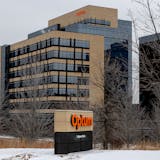In the 1980s, a computer-chip manufacturer in Bloomington needed a new factory to make products that met the security demands of the federal government and military.
On a ridge just above the Minnesota River, near what is now the Mall of America, it built a plant with copper-lined walls to block electromagnetic radiation and prevent snooping. By the standards of the fast-moving industry, the factory should have outlived its usefulness and closed 10 to 15 years ago.
Instead, the chip factory is thriving as SkyWater Technology Inc., a contract manufacturer. The small, secure plant makes economic sense again after the industry's fundamentals underwent a change no one saw coming.
"Many of the customers we work with can't consume enough silicon to justify" being in giant, leading-edge factories, said Tom Sonderman, SkyWater's chief executive.
For decades, bigger was always better in chipmaking. Size lowered costs in chip factories and their main component, silicon wafers. But as chips are made and used in an increasing number of products — from basketballs to tires — they don't need to be produced at the million-unit levels that are needed for chips used in smartphones and PCs.
"We're not forced to think about high-volume manufacturing," Sonderman said. "In many ways, we're a natural place for people to innovate and do it in a way where they feel like their intellectual property is protected."
Factories like SkyWater that were on the cutting edge in the 1980s and 1990s, when the U.S. dominated the semiconductor industry, are running at full capacity again. And the long slide of chipmaking away from the United States to other countries has slowed down markedly.
"Everybody thought they were going to die out," Dan Hutcheson, chief executive of VLSI Research and a longtime industry observer, said of the old factories. "But there's a renaissance around them."


